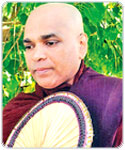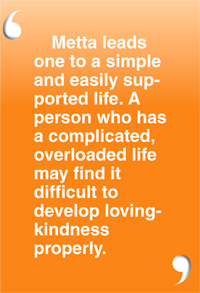|
Path to Nibbana : part 10
Happy thoughts for others
 Battaramulla Battaramulla
Siri Sudassanarama
sadaham senasuna
Ven. Dr. Mirisse Dhammika thero
A materialistic and egocentric life is characterized not only by an increase in
wans but also by restlessness, showing itself in being over-busy and over-active
and lacking in moderation and self-restraint. Metta, which promotes the
well-being of al, naturally has to be built on such qualities of sober humanism
as are reflected in having a few meaningful and select tasks which conduce to
the maximum well-being of all concerned.
 As Buddharakkhita realized, when one becomes “over-busy and over-active”, his
mind is restless, and this state of mind is liable to generate anger and
resentment. Therefore, by avoiding an over-busy and over-active life, and by
following a “simple life” as an expression of metta, one reorients one’s outlook
and conduct, especially in relation to our competitive, pleasure-seeking and
money-minded world. A person of simple living can be gentle, yet efficient and
effective, and has restraint over her sense-faculties; she is frugal,
self-disciplined and exercises moderation. Mental cultivation through meta
meditation allows for such a person to she is surrounded by a very materialistic
world. Metta leads one to a simple and easily supported life. A person who has a
complicated, ” overloaded” life may find it difficult to develop loving-kindness
properly . As Buddharakkhita realized, when one becomes “over-busy and over-active”, his
mind is restless, and this state of mind is liable to generate anger and
resentment. Therefore, by avoiding an over-busy and over-active life, and by
following a “simple life” as an expression of metta, one reorients one’s outlook
and conduct, especially in relation to our competitive, pleasure-seeking and
money-minded world. A person of simple living can be gentle, yet efficient and
effective, and has restraint over her sense-faculties; she is frugal,
self-disciplined and exercises moderation. Mental cultivation through meta
meditation allows for such a person to she is surrounded by a very materialistic
world. Metta leads one to a simple and easily supported life. A person who has a
complicated, ” overloaded” life may find it difficult to develop loving-kindness
properly .
 Metta is nota form of attachment in that it is not selfish love for another.
When one loves others out of attachment, one is ultimately aiming at satisfying
oneself. One is using others for one’s own satisfaction. This is not true metta.
Metta is instead having happy thoughts for others, in a some-what detached
manner, much as a doctor may compassionately help you without becoming
emotionally involved with you: this state of mind is free from self-interested
thoughts or self-satisfying thoughts. Such a doctor is full of compassion, and
thoughts of safety for and happiness of the patient. When the mind reduces its
selfish attachments towards worldly things, such a mind takes the opportunity to
practice equanimity: the equal response to everything, by gradually reducing
negative opinions or feelings such as dislike and conceit, as well as the
attachment to a desired outcome. When one is attached to the result, what
started out as metta may turn into calculated, avaricious thinking. Metta is nota form of attachment in that it is not selfish love for another.
When one loves others out of attachment, one is ultimately aiming at satisfying
oneself. One is using others for one’s own satisfaction. This is not true metta.
Metta is instead having happy thoughts for others, in a some-what detached
manner, much as a doctor may compassionately help you without becoming
emotionally involved with you: this state of mind is free from self-interested
thoughts or self-satisfying thoughts. Such a doctor is full of compassion, and
thoughts of safety for and happiness of the patient. When the mind reduces its
selfish attachments towards worldly things, such a mind takes the opportunity to
practice equanimity: the equal response to everything, by gradually reducing
negative opinions or feelings such as dislike and conceit, as well as the
attachment to a desired outcome. When one is attached to the result, what
started out as metta may turn into calculated, avaricious thinking.
In practicing metta, it is not enough that one should behave in a good way. When
one follows metta, his way of thinking should also change, especially regarding
the welfare of others. When one’s mind becomes infused with true metta through
sustained metta meditation, one thinks, perceives, feels, and of course, acts,
in the mode of metta. Blow I summarize for further discussion the
characteristics associated with metta:
(1) Non-hatred and the sharing of joy and happiness for all.
(2) on-hostility and the irradiating light of sympathy and empathy.
(3) Without using harsh words and with using wholesome speech.
(4) By restraining from destructive, anti-social behavior and by building
harmony and friendliness.
(5) Without conceit and with equanimity.
Loving-kindness and compassion neutralize and disperse anger, hostility, conceit
and destructive thoughts towards others, making it difficult for the latter to
dwell in the mind. In other words, a mindset of metta forces out negative
emotions and attitudes by actively putting into practice the correlative
positive ones. It is only when one actively practices non-hatred and equanimity
towards all beings that one can outgrow the tendency to entertain negative
thoughts and emotions towards those who are disliked and perceived as a threat.
However, one does not have to be fully free of negative thoughts in order to
practice metta. Metta is used as a way to gradually reduce negative thoughts. |